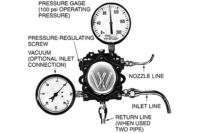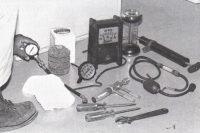Bob is a service technician who is well trained and nationally certified. However, he has sometimes suffered from the same confusion that all technicians occasionally do — the facts that he gathers may or may not point to the obvious cause of the problem or the best solution. But Bob has had something that no one else has. He recalled his long-time HVACR mentor and imagines him accompanying him as “Btu Buddy,” someone who reminded him to take time to stop and think before rushing to judgment, helping keep him on the right track, even with facts that are confusing.
Now, Bob’s company has promoted him to help train a new employee, right out of a school specializing in HVAC, just like Bob was. Bob is now Tim’s Btu Buddy. Tim is anxious to travel with Bob. Tim realizes that he is right out of school, with the theory and lab work that he accomplished in school, but still needs help. He knows that he worked with many of the components of the systems in the school, under ideal conditions with good light and air conditioning. Now it is into the field, sometimes under the house with poor lighting, or out on the rooftop in the sun, where the real action is. He is naturally and normally reluctant, but he has Bob to help guide him.
Bob and Tim were on their last service call for the day. It was an apartment house with a heat pump and the weather was warm during the day and cool at night. The tenant had just moved into this apartment and was trying to get the air conditioning to operate to her satisfaction and she said it was too breezy.
Bob and Tim started to take a look around the room with the unit operating. Sure enough along the outside wall in the living room there was a cool breeze when the air conditioning was running. Bob and Tim looked over the rest of the system while the homeowner was doing her chores.
Tim said, “There is a breeze on this outside wall. If this were cold weather you would think that breeze would be warm and feel good. However, the weather is hot and the breeze is cool.”
Bob said, “The air handler is in the center of the structure like most apartment house air handlers are. They are located there for economy. You will notice that there is quite a bit of air noise and quite a bit of air velocity to this system. Systems in apartments and condominiums typically have the air handler in the middle of the floor plan facing outward with a return air grille down next to the floor (Figure 1). There is nothing we can do to change the system, so I think we must try to make adjustments in the air pattern to slow the air down. The first thing we need to do is check the filter and the fan wheel to see if either is dirty. I wouldn’t think they are dirty with this amount of airflow, but that needs to be checked first.”
Tim asked, “How can we make air adjustments without knowing how much air is flowing?”
Bob said, “Let’s see if we can get a readout on how much air is flowing in this air handler:
1. Turn the fan to the fan on position and turn the heat to emergency heat, which will only operate the electric strip heat.
2. Now turn the thermostat up so that only the electric heat is operating. Notice that the system has two 5 kW strip heaters.
3. Measure the amperage of the entire system with the strip heaters and fan motor on.
4. Check the air temperature rise across the unit.
5. Use the formula Power = I (amperage) x E (voltage) to determine how much energy the heating elements are transferring into the air in watts.
6. We will then have to change Kilowatts to Btu per hour (Btuh). Btuh = watts x 3.413 Btu/Kilowatt.
7. Now use the formula Cubic Feet per Minute (cfm) = Qs/1.08 x TD to determine the amount of airflow we have. If we have too much airflow, we can slow the air and help the problem. We know that this is a 2-ton unit and that we need about 400 cfm per ton of air conditioning capacity so this unit should be operating at about 800 cfm.
8. We can get it close to perfect with this method (Figure 2).”
Tim started taking readings and writing them down.
Tim then asked, “Where did you get that formula and how does it work?”
Bob said, “This is the sensible heat formula for airflow. Qs is the total heat in Btuh transferred into the air. The 1.08 is a constant that converts pounds of air to cubic feet of air per minute. It is derived from multiplying the specific heat of air (0.24) x 60 minutes per hour / the specific volume of air (13.33 cubic feet per pound) = 1.08. The constant keeps this calculation out of the equation.”
Tim said, “The amp draw was 45 amps, the voltage was 230 volts, and the temperature difference was 32°F.”
Bob said, “Using the formula:
P = I x E
Power = 45 amps x 230 volts
Power = 10,350 watts
10,350 watts x 3.413 Btu per watt = 35,324.6 Btuh of heat transferred into the air.
“Now we can use the sensible heat formula to find the airflow:
cfm = Qs /1.08 x TD
cfm = 35,324.6 / 1.08 x 32
cfm = 1,022
“As we said before, this unit really requires about 400 cfm per ton of air conditioning capacity, which would call for 800 cfm. We have way too much airflow.”
Tim then said, “The fan motor is tapped to run on high speed. What should I do?”
Bob said, “I believe you can move it down to the low speed tap. Let’s try that.”
Tim moved the motor tap down to low speed and restarted the system. They then used the louvers in the supply registers to spread the air out more. They were set for all of the air to flow straight out of the register concentrating all of the air on the opposite wall causing a breeze.
They started the system up using the new lower fan speed and it reduced the airflow considerably. They did an airflow test and the system was estimated to be producing 750 cfm of air.
Bob said, “That is a little on the low side of the recommended airflow, but it will get the job done and I believe it is acceptable.”
They had the tenant check the feeling of the airflow on the outside wall and she said, “That is great. I can still feel it a little bit, but it is much less.”
They put their tools in the truck and as they were riding away Tim said, “Proper airflow is necessary for more than system performance. The airflow at the terminal units is also important. When the customer is sitting in a chair and not moving around, they will really notice air velocity.”
Bob said, “A properly sized system with poor air distribution can be a problem. Apartment systems are often low budget jobs with no regard to the airflow and how it feels to the tenant. Sometimes all they think of is the first cost of the system.”
Publication date: 6/20/2016
Want more HVAC industry news and information? Join The NEWS on Facebook, Twitter, and LinkedIn today!












